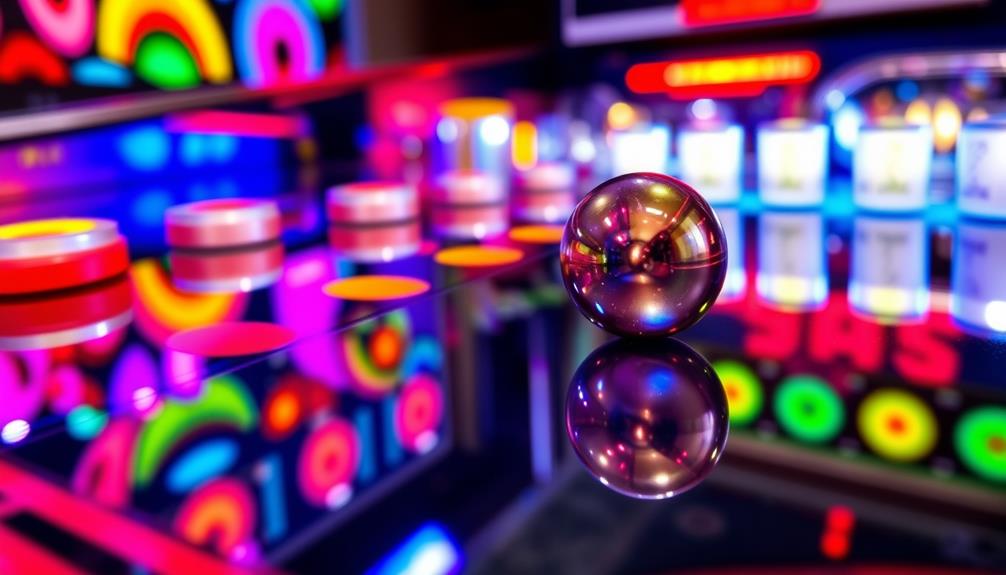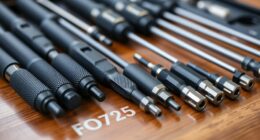If you’re looking to keep your pinball arcade shining bright, I recommend checking out the top LED testers designed for easy diagnostics and quick repairs. These tools support a wide voltage range, have clear digital displays, and feature adjustable settings for testing LEDs, strips, and backlights. Durable and user-friendly, they help you identify faulty components efficiently. If you stick around, I’ll share details on the best models to ensure your arcade stays in perfect glow.
Key Takeaways
- These testers support testing LED backlights, strips, beads, and panels, crucial for maintaining pinball machine illumination.
- They feature adjustable voltage and current for precise diagnostics of LED components in arcades.
- Compact, portable designs allow easy field testing and quick troubleshooting of pinball LED lighting issues.
- Automatic voltage regulation and safety protections ensure accurate readings and user safety during testing.
- Compatible with various LED types used in pinball machines, helping keep arcade lighting bright and reliable.
LED Light and TV Backlight Tester, Voltage LED Strip Lamp Beads Repair Tool
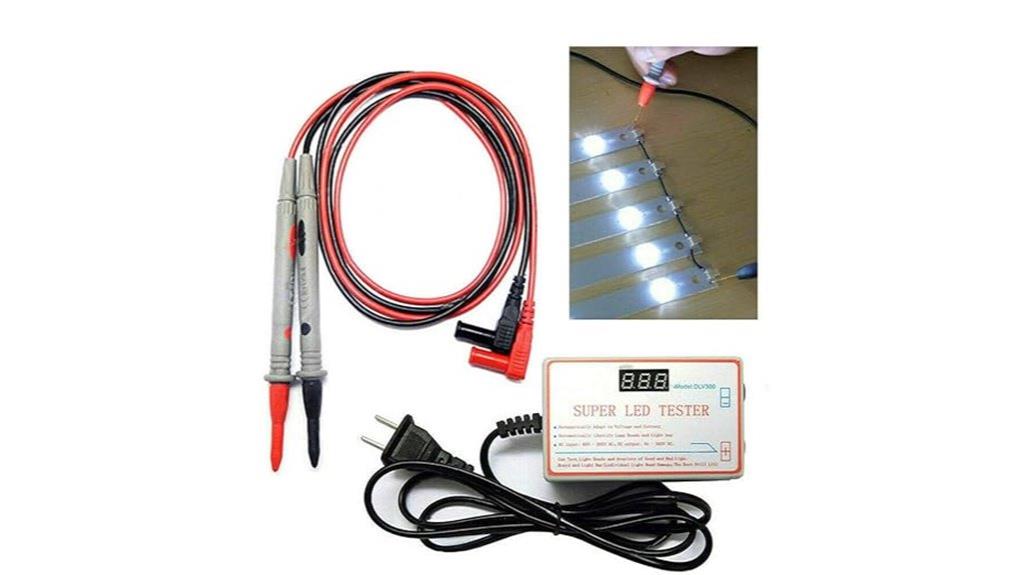
If you’re looking for a reliable tool to diagnose LED backlight problems quickly, the LED Light and TV Backlight Tester is an excellent choice. I’ve used it to identify faulty LEDs in various TVs, from Sony 4K models to Samsung and Hisense screens. The device features an LCD display, easy-to-use interface, and automatic voltage adjustment, making testing straightforward. Its gold-plated pins ensure accurate readings, and it supports 0-300V, adaptable for all LED repairs. This tool not only saves time but also reduces repair costs—allowing me to fix backlights efficiently without expensive replacements. It’s a must-have for DIY enthusiasts and professionals alike.
Best For: DIY enthusiasts and professional technicians seeking an efficient, reliable tool for diagnosing and repairing LED backlight issues in various TV models.
Pros:
- Easy-to-use interface with LCD display and automatic voltage adjustment for quick testing.
- Supports a wide voltage range (0-300V), suitable for all LED light repairs.
- High reliability with gold-plated pins ensuring accurate readings and durable performance.
Cons:
- May require some familiarity with electrical testing for optimal use.
- Not suitable for testing LED strips or lights outside the specified voltage range.
- Limited to LED backlight testing; not designed for other electronic repairs.
LED Light and TV Backlight Tester, 0-300V
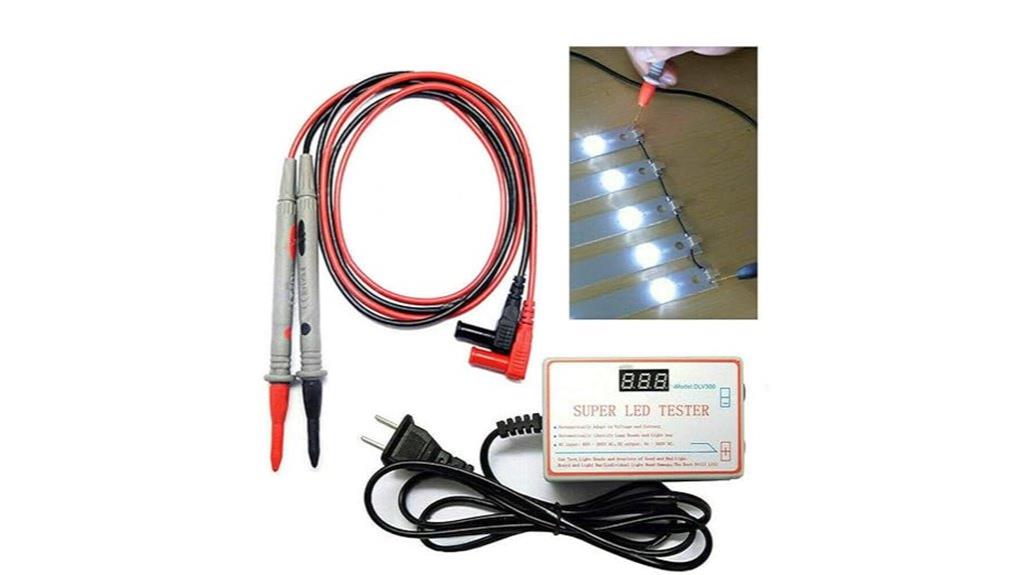
The LED Light and TV Backlight Tester, 0-300V, stands out as an essential tool for DIY enthusiasts and professional technicians alike, thanks to its adaptive voltage feature. It’s designed for testing a wide range of LED lights and TV backlights quickly and accurately. With its gold-plated pin, LCD display, and easy-to-use interface, I can effortlessly diagnose faulty LEDs, restore backlights temporarily, and speed up repairs. The automatic voltage adjustment ensures safe and reliable operation across various devices. This tester not only saves me time but also notably reduces repair costs, making it a must-have for anyone working on LED or TV backlight repairs.
Best For: DIY enthusiasts and professional technicians seeking an efficient, reliable tool for diagnosing and repairing LED and TV backlight issues.
Pros:
- Adaptive voltage feature ensures safe and accurate testing across various devices
- Easy-to-use interface with LCD display simplifies diagnostics for all skill levels
- Cost-effective solution that reduces repair time and expenses
Cons:
- Limited to testing voltages between 0-300V, not suitable for higher voltage applications
- May require some basic knowledge of electronics for optimal use
- Depends on proper connection and handling to ensure accurate results
Automotive Test Light with Digital Voltage Display and Probe

A standout feature of the Automotive Test Light with Digital Voltage Display and Probe is its bright digital readout, which delivers clear, highly visible voltage readings in any lighting conditions. With 0.1V resolution, it provides quick, reliable measurements, while the bidirectional LED indicates polarity—red for positive, green for negative—making testing straightforward. Designed for 3V-48V systems, it’s perfect for diagnosing vehicle batteries, alternators, headlights, and more. Its durable ABS body, sharp stainless steel probe, and long, flexible wire ensure easy access and safety. Compact and user-friendly, it’s an essential tool for fast, accurate automotive troubleshooting.
Best For: automotive technicians and DIY enthusiasts seeking quick, accurate voltage testing and diagnostics in vehicle electrical systems.
Pros:
- Bright digital display with 0.1V resolution for clear, precise readings in any lighting conditions
- Durable construction with shatter-proof ABS body and stainless steel probe for long-lasting use
- Long, flexible 96-inch wire and alligator clip facilitate easy access across engine bays and fuse boxes
Cons:
- May require familiarity with electrical testing for optimal use
- Limited to voltage ranges between 3V and 48V, not suitable for higher voltage systems
- The probe’s sharp tip can pose safety risks if not handled carefully
LED Light and TV Backlight Tester, Voltage LED Strip Light Source Testing Tool

For anyone working with LED displays, TVs, or LED strips, this LED Light and TV Backlight Tester stands out as an essential tool. Its digital voltage display and real-time readings make diagnosing faulty LEDs quick and accurate. With an adaptive voltage range up to 300V, it automatically adjusts to prevent LED burn-out. Designed for safety and portability, it allows testing without disassembly, identifying good or bad LEDs effortlessly. The device also tests light bars and boards, saving time and money during repairs. Compact and easy to use, it’s perfect for DIY enthusiasts and professionals alike, ensuring your LED setups stay bright and functioning smoothly.
Best For: DIY enthusiasts and professionals who need a reliable, portable tool for testing and diagnosing faults in LED displays, TV backlights, and LED strips efficiently.
Pros:
- Accurate real-time voltage and current readings with digital display for precise diagnostics.
- Automatic voltage adaptation up to 300V, preventing LED burn-out and ensuring safety.
- Easy to use without disassembly, saving time and reducing repair costs.
Cons:
- Occasional need to reset device if tips contact ground or cause errors.
- Lack of a dedicated power switch, requiring unplugging for shutdown.
- Proper connection of anode and cathode is essential; incorrect wiring may result in inaccurate readings.
LED Light and TV Backlight Tester, 0-300V Voltage Testing Tool

If you’re troubleshooting LED backlights or strips across various devices, the LED Light and TV Backlight Tester with a 0-300V range is an essential tool. It’s a digital device that tests LED beads, strips, and backlights on TVs, laptops, and computers. The tester features gold-plated pins for secure connections without damaging LEDs, and an LCD display shows real-time voltage and current. Its adjustable internal voltage makes diagnosis quick and straightforward, helping you identify faulty LEDs or connections efficiently. Compact and portable, it simplifies troubleshooting, reduces guesswork, and saves money by allowing repairs instead of replacements—making it a valuable addition to any repair toolkit.
Best For: DIY enthusiasts and professionals troubleshooting LED backlights in TVs, laptops, and electronic devices to quickly diagnose and repair faulty LEDs.
Pros:
- Accurate real-time voltage and current readings on an easy-to-read LCD display
- Adjustable internal voltage for versatile testing across various LED applications
- Compact, portable design with gold-plated pins ensuring secure connections without damage
Cons:
- Some users perceive the materials as cheap and question its long-term durability
- Limited to testing LED backlights and strips; not suitable for other electronic components
- May require basic knowledge of electronics to interpret results effectively
TKDMR LED TV Backlight Tester for LED Lights Repair
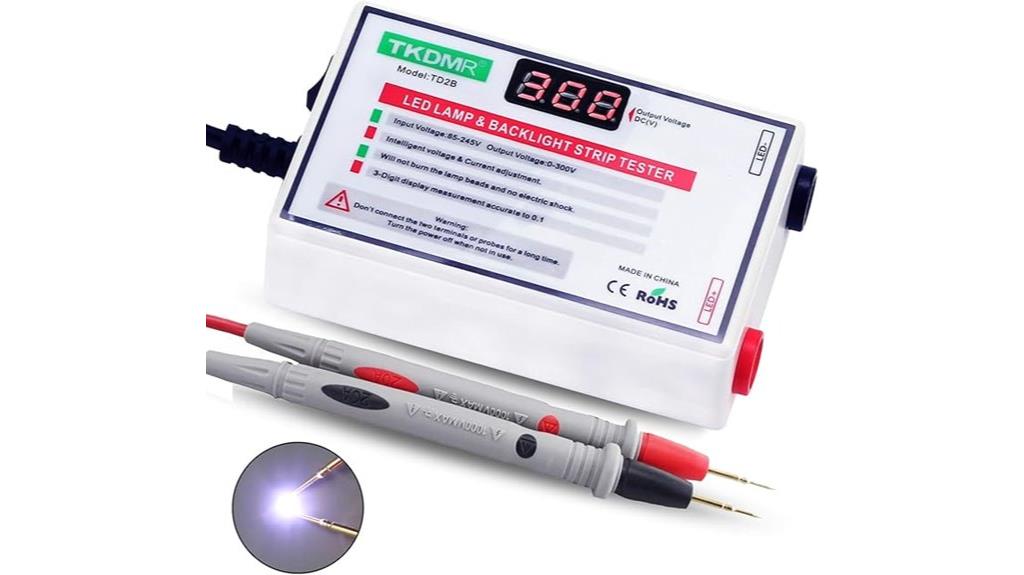
The TKDMR LED TV Backlight Tester stands out as an essential tool for technicians, hobbyists, and DIY enthusiasts aiming to diagnose LED backlight issues quickly and safely. It detects faulty LEDs without risking damage to lamp beads or panels, saving both time and money. Supporting all LED TV sizes, it tests single LEDs, strips, panels, and optical LEDs effortlessly. With automatic voltage and current adjustment, it guarantees safe and reliable operation. Compact and lightweight, it features a digital voltmeter and double isolation protection. Overall, this tester simplifies troubleshooting, making LED repair more efficient and less risky for anyone working on LED TV backlights.
Best For: DIY enthusiasts, technicians, and hobbyists seeking a safe, efficient tool to diagnose LED backlight issues in all sizes of LED TVs.
Pros:
- Provides quick and accurate detection of faulty LEDs without panel damage
- Supports testing various LED components including strips, panels, and optical LEDs
- Features automatic voltage and current adjustment for safe, reliable operation
Cons:
- Requires careful handling to avoid electric shock during testing
- May need some familiarity with electrical testing for optimal use
- Limited to LED backlight troubleshooting, not suitable for other electronic repairs
Automotive Test Light with Digital Display and Polarity Indicator
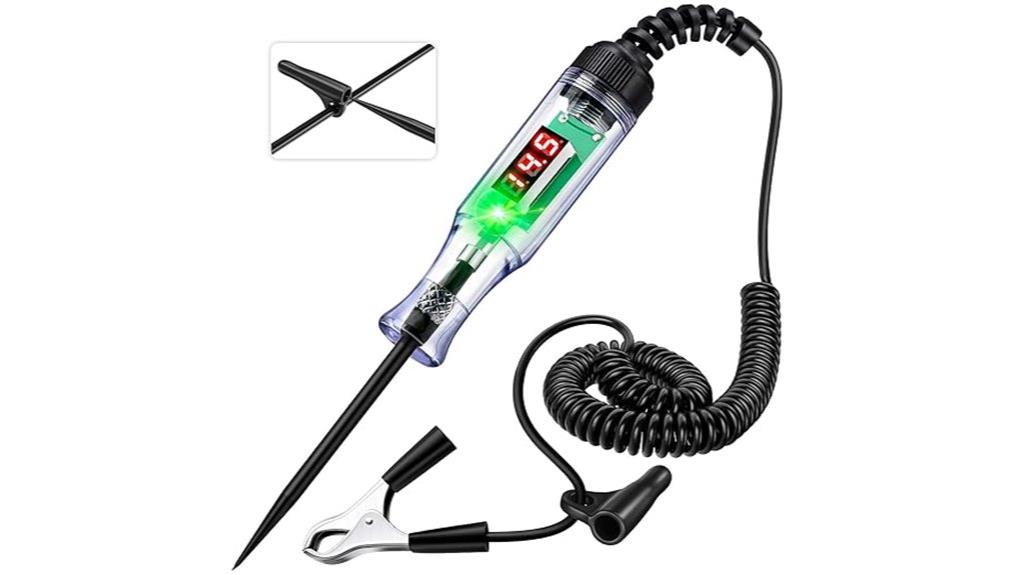
Automotive Test Light with Digital Display and Polarity Indicator stands out as an essential tool for anyone performing electrical diagnostics on vehicles. It features a 3-48V LED digital display that quickly identifies voltage issues, making circuit and battery testing straightforward. The bright, color-coded polarity indicators help me easily distinguish positive from negative, even in low-light areas. With a flexible 96-inch wire and large crocodile clips, I can reach tight spots easily and operate single-handedly. The durable stainless steel probe and insulated handle guarantee safety and longevity. Overall, it’s a reliable, affordable device perfect for routine automotive diagnostics and hobbyist projects.
Best For: automotive enthusiasts, DIY hobbyists, and professional technicians needing quick, reliable electrical diagnostics in tight or low-light conditions.
Pros:
- Bright LED digital display with clear, color-coded polarity indicators for easy reading
- Long, flexible 96-inch wire and large crocodile clips for extended reach and single-handed operation
- Durable stainless steel probe and insulated handle ensuring safety and long-term use
Cons:
- Display brightness could be improved for better visibility in bright environments
- The display may sometimes face the wrong direction, making readings harder to view
- Detects peak voltage rather than real-time changes and may respond slowly to quick voltage fluctuations
Multipurpose LED TV Backlight and Driver Tester
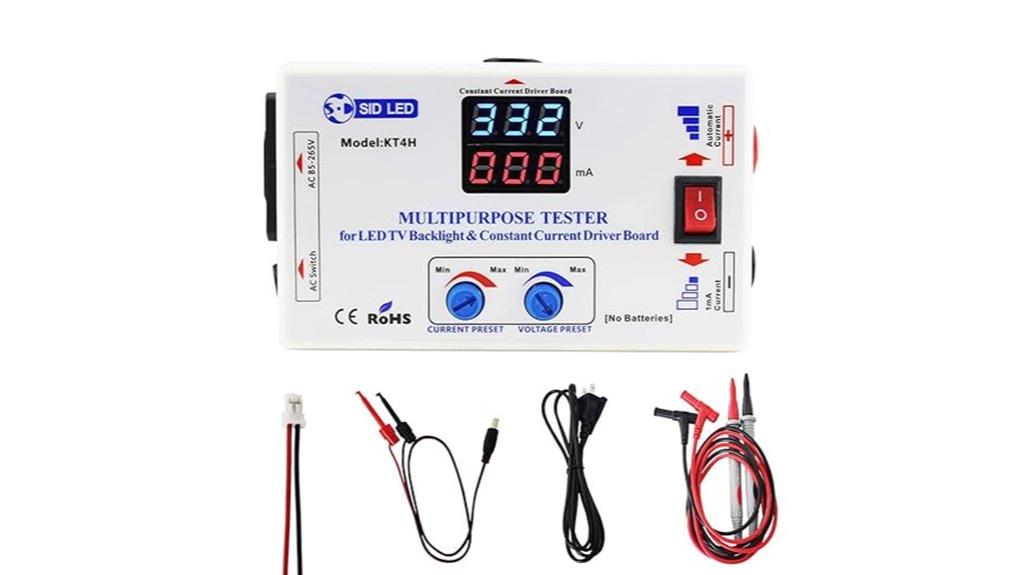
For anyone working with LED backlights, the Multipurpose LED TV Backlight and Driver Tester stands out as an essential tool. It operates on AC 85-265V input and provides adjustable DC 0-330V output, allowing precise testing of various LED components. With accuracy within ±0.5% for voltage and ±2% for current, it can handle up to 150mA current and constant current up to 999mA. I find it perfect for testing LED strips, panels, beads, COB lighting, and TV backlights. Its safe testing features prevent damage, and easy setup makes troubleshooting quick and effective, saving me time and effort during repairs or installation.
Best For: professionals and hobbyists who need an accurate, versatile tool for testing and repairing LED backlights, strips, panels, and driver boards.
Pros:
- High accuracy with ±0.5% voltage and ±2% current measurements for reliable testing.
- Supports a wide range of LED components including strips, beads, panels, and COB lighting.
- Safe testing features prevent damage to LEDs and driver boards, ensuring durability and peace of mind.
Cons:
- Maximum testing current limited to 150mA, which may not suit all high-power LED applications.
- Requires manual adjustments for voltage and current settings, which may take some initial familiarity.
- The device’s size and setup might be less portable for fieldwork compared to smaller testers.
HiLetgo LED Test Box Tester (2 pcs, 2~150mA)

If you’re a hobbyist or electronics enthusiast looking for an affordable and portable way to test LEDs quickly, the HiLetgo LED Test Box Tester offers an excellent solution. This compact device lets you evaluate LED brightness, color, and appearance by simply plugging LEDs into marked holes and pressing a button. It supports currents from 2 to 150mA, with separate sections for 2-pin and 4-pin LEDs. Powered by a 9V battery (not included), it’s small enough to carry around easily. While it provides quick, basic testing for LED functionality, keep in mind its limited accuracy and occasional build quality issues. Overall, it’s a handy tool for quick assessments.
Best For: hobbyists and electronics enthusiasts seeking an affordable, portable tool for quick LED testing and evaluation.
Pros:
- Compact and lightweight, easy to carry around for on-the-go testing.
- Simple to use with quick visual assessment of LED brightness, color, and appearance.
- Affordable option suitable for basic LED testing needs and sorting tasks.
Cons:
- Limited test accuracy due to lack of precise current regulation and potential electrical issues.
- Build quality concerns such as soldering problems, loose components, and fragile case design.
- Mechanical constraints like tight battery compartment and unreliable socket connections may require modifications.
Professional LED Bulb Automotive Circuit Tester
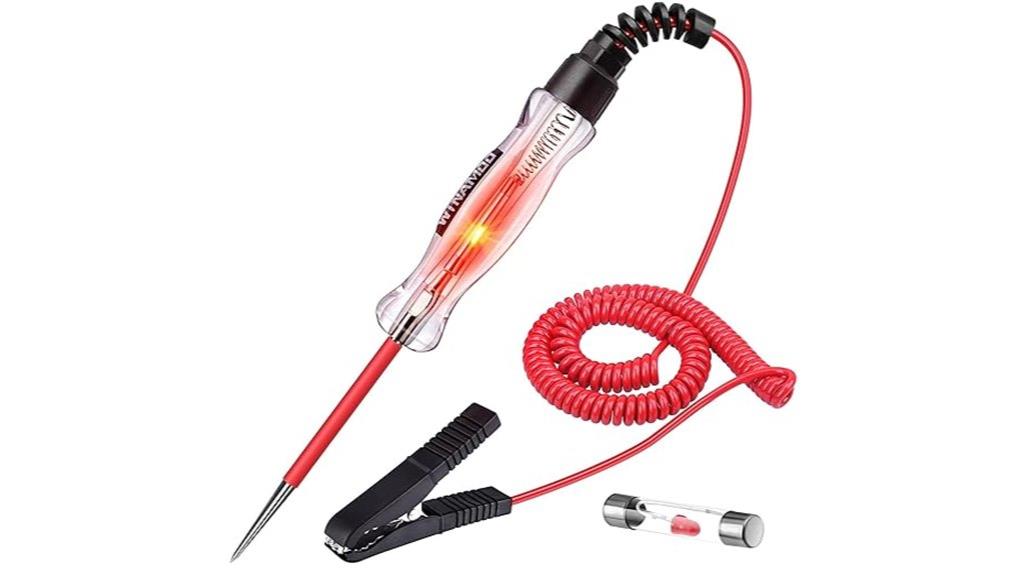
The Professional LED Bulb Automotive Circuit Tester is an essential tool for anyone diagnosing vehicle electrical issues, thanks to its wide operating voltage range of 6-24V DC. It quickly checks circuits, headlights, taillights, turn signals, and fuses, providing reliable, clear signals thanks to its high-performance LED bulb. The tester features a durable acetate fiber body, a sharp stainless-steel probe, and an extended alligator clip wire for easy access in tight spaces. It supports bidirectional testing for current and voltage, making it versatile for various troubleshooting tasks. Whether you’re a professional mechanic or DIY enthusiast, this tester simplifies diagnosing wiring faults with accuracy and ease.
Best For: DIY enthusiasts and professional mechanics seeking a reliable, versatile tool for diagnosing vehicle electrical issues within 6-24V DC circuits.
Pros:
- High-performance LED bulb provides clear, easily visible signals for accurate diagnostics
- Durable acetate fiber body and shatter-proof construction ensure long-lasting use
- Supports bidirectional testing of current and voltage for comprehensive troubleshooting
Cons:
- Limited to 6-24V DC circuits, not suitable for higher voltage applications
- May require familiarity with electrical testing procedures for optimal use
- Extended wire length may be cumbersome in very tight or confined spaces
Liphontcta LED Lamp Bead TV Backlight Tester

The Liphontcta LED Lamp Bead TV Backlight Tester stands out as an essential tool for professionals and DIY repair enthusiasts who need a reliable way to quickly diagnose LED lighting issues. It supports voltages up to 300V and can test various LED sources like strips, lamp boards, COB lights, and individual beads without removing screens. Its automatic regulation ensures safe operation and accurate results, while its compact design makes testing easy and efficient. Whether checking for burnt-out LEDs or circuit issues, this tester simplifies troubleshooting. Overall, it’s a versatile, user-friendly device that helps keep your LED backlights shining bright and functioning properly.
Best For: professionals and DIY enthusiasts seeking an easy, reliable tool for diagnosing LED backlight and circuit issues in TVs and electronic devices.
Pros:
- Supports testing voltages up to 300V and various LED sources without disassembly
- Automatic regulation ensures safe operation and accurate results
- Compact, lightweight design for convenient testing and handling
Cons:
- Some users may experience difficulty understanding proper usage or troubleshooting device malfunctions
- Not battery-powered; requires connection to mains power, limiting portability
- Occasional reports of malfunction or inconsistent performance despite safety features
LED TV Backlight Tester with LCD Display and Adaptive Voltage
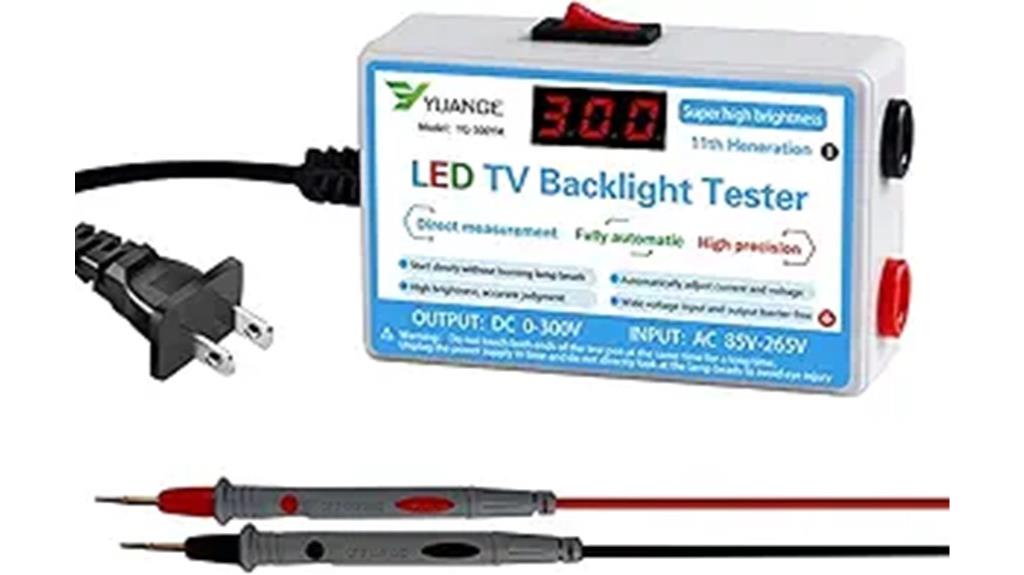
A standout feature of the LED TV Backlight Tester with LCD Display and Adaptive Voltage is its fully automatic voltage and current regulation, making it ideal for technicians and DIY enthusiasts who need quick, accurate diagnostics without complex setup. It supports testing various light sources like LED strips, lamp boards, COB lights, and individual beads without removing the screen. With an adjustable voltage output of 0-300V and current options of 15/30mA, it guarantees safe, reliable operation through reverse protection and double isolation. Its LCD display provides clear readings, and the device’s compact size makes it easy to use for troubleshooting LED backlights and electronic components efficiently.
Best For: DIY enthusiasts, electronics technicians, and repair professionals seeking a safe, accurate, and easy-to-use tool for testing LED TV backlights and electronic components.
Pros:
- Fully automatic voltage and current regulation for quick and precise diagnostics
- Supports testing various light sources without screen removal, saving time and effort
- Compact, portable design with LCD display for clear readings and safe operation
Cons:
- Probes may require replacement or adjustment for optimal performance
- Limited current options (15/30mA) may not suit all testing needs
- Manual may lack detailed troubleshooting instructions for complex issues
Automotive Test Light with Digital Voltage Display

If you’re working on automotive electrical systems, an automotive test light with a digital voltage display offers precise and quick diagnostics. Its voltage range of 5V-120V covers batteries, alternators, headlights, and more, making it versatile for cars, trucks, SUVs, and boats. The bright LED screen provides clear, accurate readings with 0.1V resolution, while polarity indicators prevent misconnection. The durable stainless steel probe and 96-inch spring wire give you extended reach, and the large alligator clip allows for easy one-handed testing. Built-in circuit functions and solid construction make this tool reliable, efficient, and perfect for both DIYers and professionals.
Best For: DIY enthusiasts and automotive professionals seeking a reliable, accurate, and versatile tool for electrical diagnostics across various vehicles and systems.
Pros:
- Bright LED display with 0.1V resolution ensures precise readings in any lighting condition.
- Durable stainless steel probe and 96-inch flexible wire provide extended reach and easy access to hard-to-reach areas.
- Built-in circuit functions and polarity indicators enhance safety and diagnostic accuracy.
Cons:
- May be less suitable for very high voltage applications beyond 120V.
- The long wire, while flexible, can be cumbersome to manage in tight spaces.
- Requires careful handling to avoid damage to the probe or wiring during heavy-duty use.
Automotive Test Light with Digital Voltage Display and Probe

Automotive professionals and DIY enthusiasts will appreciate the Digital Voltage Display and Probe for its precise readings and versatile testing capabilities. This tool features a 3-120V LED digital display, ideal for diagnosing various DC circuits like batteries, headlights, and fuse connections. Its sharp stainless steel probe easily pierces insulation, reaching tight spaces, while the 106-inch spring wire offers flexibility for large-area testing. The large alligator clip allows one-handed operation, making troubleshooting quick and efficient. With clear 0.1V resolution and polarity indicators, this test light guarantees accurate, safe readings across multiple vehicle types, from motorcycles to boats.
Best For: automotive technicians and DIY enthusiasts seeking accurate, versatile electrical testing for a wide range of vehicle circuits.
Pros:
- Precise 0.1V digital display with clear readings and polarity indicators.
- Sharp stainless steel probe capable of piercing insulation and reaching tight spaces.
- Long 106-inch flexible spring wire and large alligator clip for ease of use over large areas.
Cons:
- Some users have noted minor fit issues with the clip protector.
- Build quality may vary slightly compared to higher-end meters.
- Limited to testing DC circuits within the 3-120V range, not suitable for AC or higher voltages.
DEVMO Mini LED Tester for Light-Emitting Diodes

The DEVMO Mini LED Tester is ideal for hobbyists and DIY enthusiasts who need a portable, quick way to verify LED functionality. Its compact size and simple design let you plug in LEDs and press a button to check brightness, color, and current draw. Supporting 2-150mA, it works with both 2-pin and 4-pin LEDs across two current ranges. However, despite its convenience, build quality issues like missing screws, flimsy casing, and poor internal soldering are common. While it generally performs basic tests, inconsistent performance and questionable durability mean it’s best for casual use rather than precise or professional testing.
Best For: hobbyists and DIY enthusiasts seeking a portable, budget-friendly tool for quick LED functionality checks.
Pros:
- Compact and lightweight, easy to carry and use on the go
- Supports testing of both 2-pin and 4-pin LEDs across a range of currents
- Simple operation with straightforward plug-and-press testing process
Cons:
- Poor build quality with missing screws and flimsy casing that may fall apart
- Inconsistent performance due to internal soldering issues and inaccurate resistor values
- Not suitable for precise or professional electrical testing or detailed analysis
Factors to Consider When Choosing a Pinball LED Tester
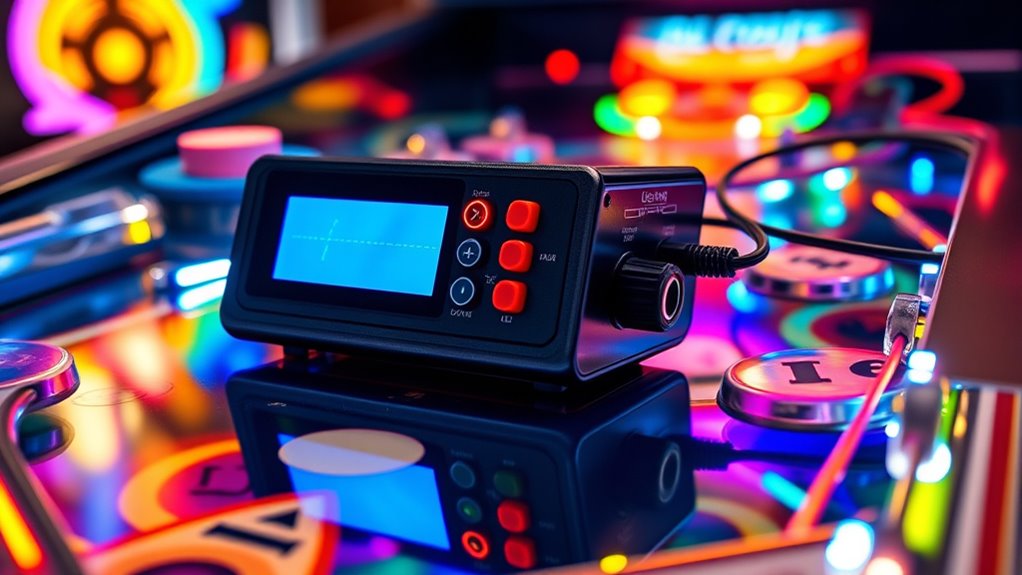
When choosing a pinball LED tester, I consider factors like compatibility with different pinball models and the testing voltage range to guarantee it works with my setup. Ease of use, durability, and build quality are also key, so I don’t waste time or money on fragile or complicated devices. Finally, I weigh the cost and value to find a tester that offers the best performance without breaking the bank.
Compatibility With Pinball Models
Choosing the right pinball LED tester requires verifying it’s compatible with your specific machine’s lighting setup. First, verify that the tester supports your pinball’s voltage and current requirements to prevent damage or inaccurate testing. It’s also essential to confirm compatibility with your machine’s LED configuration—whether it’s single-color, RGB, or custom LEDs. Additionally, check if the tester can handle the connector types and pin layouts used in your circuit board. Size and design matter too; the tester should fit into tight spaces within the cabinet and control panels easily. Finally, verify it can test both individual LEDs and larger LED strips or modules specific to your pinball model. Compatibility ensures accurate testing and a seamless experience.
Testing Voltage Range
Ensuring your pinball LED tester has the right voltage range is essential for accurate and safe diagnostics. You want a tester that supports from around 5V up to 300V to cover different LED types, including indicator lights and backlights. An adjustable or auto-ranging feature is necessary to accurately test both low-voltage LEDs and high-voltage components without risking damage. It’s also imperative to confirm the tester can handle the maximum voltage in your pinball machine’s circuits to avoid inaccurate readings or equipment failure. A broader voltage range enhances versatility, letting you test various LED components and strips. Lastly, reliable voltage measurement within the specified range, with clear readings, ensures effective troubleshooting and prevents misdiagnosis.
Ease of Use
A pinball LED tester that’s easy to use makes troubleshooting much simpler, especially for those new to the hobby or working under time constraints. A clear, intuitive interface with straightforward controls minimizes the learning curve and speeds up the process. Visual indicators like LED lights, digital displays, or sound alerts help me quickly interpret results without complex calculations. Well-labeled ports and simple connection methods ensure proper LED placement and testing accuracy, reducing errors. Ergonomic design features, such as comfortable grips and accessible buttons, make prolonged testing more manageable. Built-in safety features and minimal setup steps further enhance usability by preventing user mistakes and providing a smooth testing experience. Overall, a user-friendly tester saves time and frustration, making maintenance more efficient.
Durability and Build Quality
Durability and build quality are essential when selecting a pinball LED tester because these devices often face frequent use and rough handling. A solid tester should be made from impact-resistant materials like reinforced plastics or metal, ensuring it can withstand drops and bumps. The probes and connectors must feature robust gold-plated or stainless steel contacts to resist corrosion and provide reliable connections over time. Built-in protective features, such as shockproof casings and insulated handles, help prevent damage from electrical surges or accidental drops. Additionally, sturdy joints and seams reduce the risk of breakage or loosening after extended use. The overall build quality should reflect tight assembly, minimal loose parts, and high manufacturing standards, all of which contribute to a long-lasting, dependable device that maintains performance in demanding environments.
Cost and Value
Choosing a pinball LED tester that offers the right balance between price and features is essential for getting good value. I look for models that provide critical functions like adjustable current, multiple testing modes, and a clear display without overpaying. Durability is also key—I want a tester built to withstand frequent use, saving me money on repairs or replacements. Comparing prices across similar models helps me ensure I’m getting competitive pricing for the accuracy and functionality offered. Sometimes, investing a bit more upfront in a higher-quality, reliable tester pays off by reducing false readings and preventing LED damage, ultimately saving me time and money. A well-priced, feature-rich tester is an investment that keeps my arcade shining bright without breaking the bank.
Safety Features
Safety features are vital when selecting a pinball LED tester because they protect both the user and the device during testing. Double insulation and protective covers are essential to prevent electrical shocks, especially when working with high voltages. Look for testers with reverse polarity protection, which helps avoid damage or false readings if connections are reversed. Automatic shut-off features are valuable, as they prevent overheating or short circuits during extended use. Clearly marked voltage and current limits ensure you don’t overload LEDs or harm the tester itself. Additionally, devices with built-in fuse protection or circuit breakers add an extra layer of safety by preventing excessive current flow that could lead to electrical hazards. Prioritizing these safety features helps keep your testing process secure and reliable.
Frequently Asked Questions
How Do I Interpret LED Tester Readings Accurately?
To interpret LED tester readings accurately, I focus on the indicator lights or display. A lit LED usually means it’s functioning correctly, while a dim or unlit LED indicates a problem. I always compare the readings to the tester’s manual, ensuring I understand what each light or symbol signifies. If in doubt, I double-check connections and test the LED in a different circuit to confirm whether it’s faulty or just a reading anomaly.
Can LED Testers Identify Faulty Pinball LEDS?
Yes, LED testers can identify faulty pinball LEDs. I rely on them to quickly check if an LED is dead or malfunctioning. When I use a tester, I look for specific indicators like no light or inconsistent brightness. It’s a straightforward process that saves me time and helps keep my arcade shining bright. If an LED doesn’t light up or shows irregular readings, I know it’s time for a replacement.
Are Portable LED Testers Suitable for On-The-Go Repairs?
Imagine slipping a sleek, compact LED tester into your pocket as easily as tucking in a card. Yes, portable LED testers are perfect for on-the-go repairs. They’re lightweight, durable, and designed for quick checks, making it simple to diagnose issues anytime, anywhere. I’ve used mine during arcade visits and repair sessions, and they’ve saved me time and hassle. If you need flexibility, a portable tester is definitely the way to go.
What Safety Precautions Should I Follow When Testing High-Voltage LEDS?
When testing high-voltage LEDs, I always prioritize safety. I make sure to wear insulated gloves and eye protection to avoid shocks or debris. I double-check my tester’s settings and confirm the power is off before connecting any components. I also work in a dry, well-lit area, and never touch exposed wires during testing. Staying cautious helps me prevent accidents and handle high-voltage parts safely.
How Often Should I Calibrate My Pinball LED Tester?
Think of calibrating your pinball LED tester like tuning a musical instrument; it keeps everything in harmony. I recommend calibrating your tester at least once every six months, or more often if you notice inconsistent readings. Regular calibration guarantees accuracy and longevity of your device. Don’t forget, environmental factors like temperature and humidity can affect calibration, so always perform it in a stable setting.
Conclusion
Choosing the right pinball LED tester can make all the difference in keeping your arcade shining bright. For example, I once used a simple LED tester to quickly identify a faulty backlight, saving me hours of troubleshooting. Whether you’re repairing a TV backlight or testing pinball LEDs, these tools ensure accurate results and save time. Invest in the right tester today, and keep your arcade glowing brilliantly for years to come.

